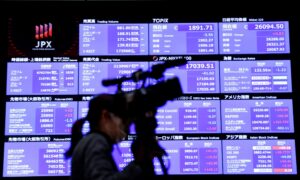Shares and Bonds Ride High After Soothing Eurozone Data
Distressed Patriotic Flag Unisex T-Shirt - Celebrate Comfort and Country $11.29 USD Get it here>>


LONDON—Share markets pushed for a fifth straight day of gains on Friday and bonds headed for their best month since 2008, as a record monthly drop in the eurozone’s inflation rate raised investors’ expectations for similar U.S. data later in the day.
With an action-packed first quarter also drawing to a close world stocks were consolidating a 6 percent year-to-date rise. Government bonds have gained as much as 5 percent, gold is 8 percent higher, while oil is down and the dollar has barely budged.
The eurozone inflation numbers showed consumer prices rising 6.9 percent in March after an 8.5 percent increase in February, representing the sharpest deceleration since Eurostat started collecting data in 1991.
“The brakes are on the economy, but slowly,” said Hans Peterson, the global head of asset allocation at SEB investment management. “So down the road we will have to see what the central banks do.”
Europe’s main stock markets and Wall Street futures were all up around 0.3 percent after Asian equities overnight notched up their first March gain in four years.
That part of the world has been lifted by China casting off its COVID-19 restrictions. MSCI Asia ex-Japan has added 3.6 percent so far this year after surging 12 percent in the final quarter of 2022.
Japan’s Nikkei also jumped 1 percent on Friday, as inflation data for the capital Tokyo highlighted broadening price pressures.
China and Hong Kong’s Hang Seng rose modestly too after China’s PMI data showed that the recovery in the services sector was gathering pace and manufacturing activity expanded faster than expected.
Central Focus
Wall Street was set for another modest rise after Thursday saw gains for tech stocks but falls in regional bank shares after Treasury Secretary Janet Yellen said banking regulation and supervisory rules need to be re-examined in the wake of recent turmoil.
Markets will be shifting their focus back to inflation and the outlook for Fed interest rate hikes on hopes that the banking troubles stay largely contained.
U.S. personal consumption expenditures (PCE) inflation index, which is closely tracked by the Federal Reserve, is expected to ease to 0.4 percent in February from January, when it rose 0.6 percent.
However, there is still an expectation that banks will now be more cautious about lending, which would also impact the Fed.
“The underlying source of these (banking market) stresses, which have to do with interest rates, inverted yield curves, etc., is still with us, so these stress factors have not gone away. I suspect we will see bouts of volatility in markets during 2023,” said Herald van der Linde, head of equity strategy for Asia at HSBC.
Fed funds futures are still split on whether the Federal Reserve will hike or not at the next policy meeting in May, while pricing in a rate cut by November. That compared with an overwhelming bet on a 25 basis point hike a month ago before the banking volatility started.
U.S. Treasuries have had a blockbuster month, with the two-year yields down a whopping 68 basis points to 4.1120 percent, the biggest monthly decline since the 2008 financial crash. Ten-year yields were 35 bps lower this month to 3.5602 percent, confounding those thinking they would rise.
“Everyone that was short bonds was trounced,” said Ted Pincus at Switzerland-based hedge fund Mangart Capital, referring to those who had bet on bond yields rising further.
“That’s the problem when you have these kinds of rapid moves. Stop losses exacerbate the pain.”
Off to the Races
Moves in foreign exchange markets were muted on Friday, but the U.S. dollar was on course for a 2.7 percent monthly drop against six of its peers albeit only a 1.1 percent one for the quarter.
The euro, which hit a one-week high against the dollar overnight on sticky German inflation data, dipped back under $1.09 again after the eurozone data but was still set for a 3 percent monthly rise.
Japan’s yen, which has benefitted from safe-haven flows, is headed for a 2.5 percent gain for the month, while emerging market currencies have mostly risen too.
Oil prices seesawed on Friday, and were down more than 3 percent for the month and 8 percent for Q1. U.S. crude futures were flat at $74.40 per barrel, while Brent crude futures slipped 0.1 percent to $78.52 per barrel.
Gold hovered around the highest since April last year, up more than 8 percent for the month to $1,980.20 per ounce.




